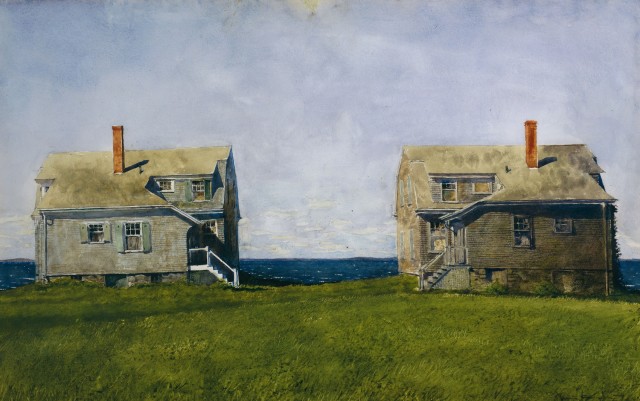
When a child comes home from sixth grade and renounces school to be a painter, most fathers would usually turn the kid around and send him right back the next morning. Unless, that is, your father is Andrew Wyeth.
As a prolific artist himself, Andrew got his start in the 1930s and passed down his painting legacy to his son Jamie. Born in 1946 with art in his veins, Jamie left school at an early age to focus on the family business.
“People ask, ‘How’d you know at that age?’ But that’s all I did was paint and draw, and that’s all I still do,” Jamie says.
For the first time, the works of both artists hang side by side in one exhibit — Wyeth: Jamie and Andrew in the Studio, now at the Denver Art Museum through Feb. 7. The show winds through the seven decades of work from both Jamie and his late father, who passed in 2009.
The exhibit started as a passion project for curator Timothy Standring, who spent the last five years combing through each artist’s career, attempting to create a conversation between father and son. Likening the process to conducting an orchestra, Standring was able to find patterns in the duo’s work that express their myriad similarities and differences.
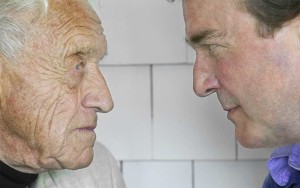
Jamie grew up making art in a studio next door to his father’s. He says he’d pop in and out of his father’s studio and while the two would sometimes interact, each was in their own separate world. Jamie cites inspiration from his grandfather N.C. Wyeth, who died just before Jamie was born. N.C. was a well-known artist and illustrator whose work appeared in magazines and books, most notably in classic fantasy stories.
“I’d wander up to [N.C.] studio … and there were compasses, buzz saws, flint lock rifles. And it was filled with all of his illustrations still, as if he’d walked out of there an hour before. That was just magical. I’d spend hours there pouring over that stuff,” Jamie says. “When I’d walk back down the hill to the house, there’d be my father painting some dead crow or something and that was boring as hell. I’d come from knights and Robin Hood and Treasure Island.
“So really the strongest influence for me was my grandfather. …” he says. “But I think painting is such an individual discipline, and no two are really alike. I think I’m as different from my father, as his work is from his father.”
Still, Jamie always admired his father’s work, saying he was fascinated by the airless crystallized world in his paintings. Andrew gained success early in his career — selling out his first show in 1937 at the age of 20. He had several notable pieces throughout this career, but none more so than “Christina’s World” (1948). Hanging in the Museum of Modern Art as part of its permanent collection, it is one of the most renowned paintings in American art history and was declared a National Historic Landmark in 2011.
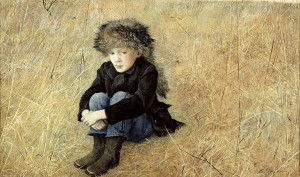
Throughout the Wyeths’ careers there are similarities weaved throughout their work, tailored to fit each individual personality, Standring says. Each was interested in fleeting moments and capturing snapshots in time. Their work is also heavily rooted in place, specifically the space close to home, usually splitting their year between Maine and Pennsylvania. Paintings will feature their friends, family, animals and landscapes in their own backyard or community. This allows the painters to fully absorb their environment and churn out immersive works.
“[I’m inspired by] generally things that I’m familiar with,” Jamie says. “Nothing interests me less than a fascinating face. But what does interest me is a face that I’ve known for a long time, and then all of a sudden I go, ‘Bingo, I have to make a record of it.’”
Jamie spends most of his year on a small island in Maine, which might suggest a lack of unique things in his surroundings to paint, but he disagrees.
“I feel like I could live three lifetimes and still not be extinguished,” he says.
Both painters are also known for their realism, but Standring wanted to expand the story and change the discourse on the Wyeths, calling them exuberant painters. The “realist” description is problematic because a brush stroke can be labeled a mistake when really it’s all about perception and the essence of the painter.
“The word realism immediately brings to mind that it’s a slavish imitation, and it’s not,” Standring says. “I think that they worked in the vernacular of realism but used that to express great empathy and create works that elicit an empathic response in us. There are people who cry in front of Andrew Wyeth’s paintings. Why is that? Because he stumbled upon something that he put so much emotional weight into.”
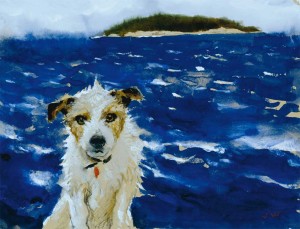
Those feelings jump off the canvas regardless of subject matter. Their work goes deeper than what they’re painting, as seen with their treatment of animals. A dog isn’t just a dog, and a seagull isn’t just a seagull. Andrew and Jamie don’t create Disney-like caricatures of animals. They present the animal in a way that infuses them with meaning, as seen in Jamie’s Seven Deadly Sins series (2005) where seagulls are used as biblical metaphors. This infusion process is what they do in all their work.
“The danger with representational painting is that people can say, ‘Oh, it looks like a photograph with every blade of hair or grass.’ … I try to look further, to look at the rough edges of where I live, not the beautiful surf, but in faces of the children of the island who live a tough life. I try to avoid cuteness or trying to look like it’s the real thing. I try to add more emotion than that,” Jamie says.
This can be seen in Jamie’s intimate portraits that feature family members, neighbors and even his friend Andy Warhol. One of Jamie’s first commissions was at age 17 when he was asked to paint a portrait of famed cardiologist Dr. Helen Taussig. Stark with harsh lighting, the painting captures a complex and interesting woman who excelled at medicine in the ’60s. Yet, not everyone appreciated the picture or the story Jamie was telling.
“When they unveiled it people asked, ‘What monster child had painted this?’ But that was more about medicine and women at the time. They wanted Betty Crocker instead of what Helen Taussig looked like. But she actually looked that way, and she didn’t object to the portrait at all,” Standring says.
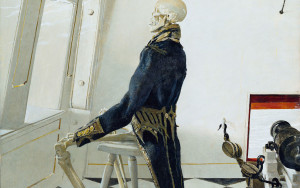
While the Wyeths’ subject matter did overlap, father and son differ in their approaches, especially in terms of technique. Andrew had a more detailed and specified way of capturing a scene, while Jamie tiptoes toward more abstract interpretations. Andrew also was less experimental with materials and worked with tempera and mostly muted colors.
Here is where we see Jamie’s true departure from this father’s work. Jamie enjoys painting with vibrant colors and playing with different materials like oil paints, gouache and mixing chalk, water and oil. And he works on different surfaces including cardboard, wood and various papers. He has also expanded outside of painting and drawings with some three-dimensional work and dioramas, which can be seen in the Wyeth exhibit.
Despite his reluctance in his own work, Andrew was always supportive of his son’s exploration.
“He was always fascinated by the different direction I was going, and he never cautioned me not to,” Jamie says. “When I left at one point to go to New York and work with Andy Warhol and all that, he never said, ‘Oh no, Jamie, you shouldn’t do this.’ He never would have done it himself. He was very covetous of his time and where he lived and digging into that. And I think he was somewhat appalled by what I was doing, but he never said that this was detrimental to my work.”
And as a great admirer of his father’s work, Jamie always valued his father’s opinion and wishes he still received it.
“I miss him being around. We were pretty honest about each other’s work because we had nothing to gain through flattering,” Jamie says. “So I miss that sort of council.”
The Wyeths have been a staple of the national art scene for three-quarters of a century, and Standring calls them the quintessential American artists. Their work captures iconic imagery from the farmhouse to the lighthouse, from household pets to farm animals, from personal portraiture to the macabre. Whether the subject matter is relatable or not, their work itself is intimate and recognizable.

For Standring, the Wyeths’ conviction to hold on to their viewpoint is what makes their work so strong. They never abandoned their passions to conform to an artistic ideal.
“It could have been easy for them to be facile or decorative. …” Standring says. “I think they’ve produced hugely memorable images that our collective mentality across America identifies with, and it’s almost inexplicable how that happens.”
The viewer imparts the meaning into the painting, and it’s never intentional, Jamie says. He doesn’t focus on the motivation behind the painting, only on painting, like what he’s done his whole life and what his father and other generations did before him.
“Painting is a peculiar discipline and is what compels me. … That’s why I don’t theorize about my work, because it tends to freeze me,” Jamie says. “I just want to keep doing it, to be excited by it and moved by it.”
On the Bill: Wyeth: Andrew and Jamie in the Studio. Denver Art Museum, 100 W. 14th Ave. Parkway, Denver, 720-865-5000. Through Feb. 7.














